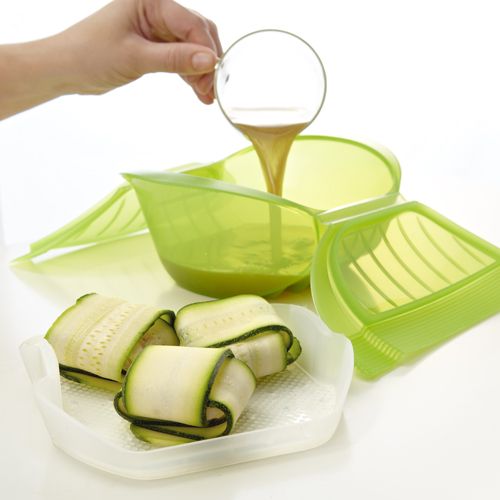Oh yes, I finally got a microwave. You may not believe it, but, luddite-like, we have steered clear of one until recently. We mostly used it for defrosting and re-heating when we first got it, as we were of course, not very good at cooking with it, you know what it’s like: rubbery potatoes, dry cauliflowers… the lot.
But I’m a sucker for design. (What the… I hear you wondering) Well, I caught sight of the Lékué Steam Case, and even though I didn’t think much of it to start with, I was sold afterwards. It looks really cool (it was designed by Luki Huber) and, with a microwave, it makes sense: it’s like cooking “en papillote”, but super fast. You could achieve the same effect by wrapping your food in non-stick paper, but the Steam Case is easier, re-usable, and it is more “sauce-friendly”.
You can use it with the tray to steam your food, or without it, if you prefer to cook it with some kind of sauce, or just in its own juices.
The most recent addition to my collection is the Ogya, a brand new “microwave pot” where you can make risotto, soup and other “soupy” dishes (had it been on the market before, I would probably have just bought this).
It’s really neat, even if I didn’t think risotto could be made in the microwave and be palatable… Well, I was wrong. I made a very nice mushroom risotto in just 15 minutes.
And then the last gadget, the Steam Roaster. This is basically a silicone bowl, where you can season or otherwise prep your food. The good thing is that, being flexible and having a lip and a slit, you can then fold the bowl to close it and cook your food in it. You use this if you want a crispier coat for your steamed food.
I know the big question is: Is it safe?
Well, all Lékué cookware is made of Platinum Silicone, so it is safe for food contact, and is tested for high temperatures. Silicon (the main component of silicone) is an inert material in itself, but it needs to be vulcanized to be used, and here’s where bad things can happen. Some companies use low grade, cheaper materials for this process, and while this is perfectly fine for non-food-grade silicone, it’s a no-no for cookware, as such cheaper materials are usually harmful and can release particles in your food, which you really don’t want. On the contrary, platinum silicone is the best quality and uses only platinum as a catalyzer (and you pay for it); is used also in surgery materials, baby bottle nipples and so on.
I am just so surprised by how good some of the dishes I cooked tasted, that I thought I’d share this with you 🙂 Enjoy.



